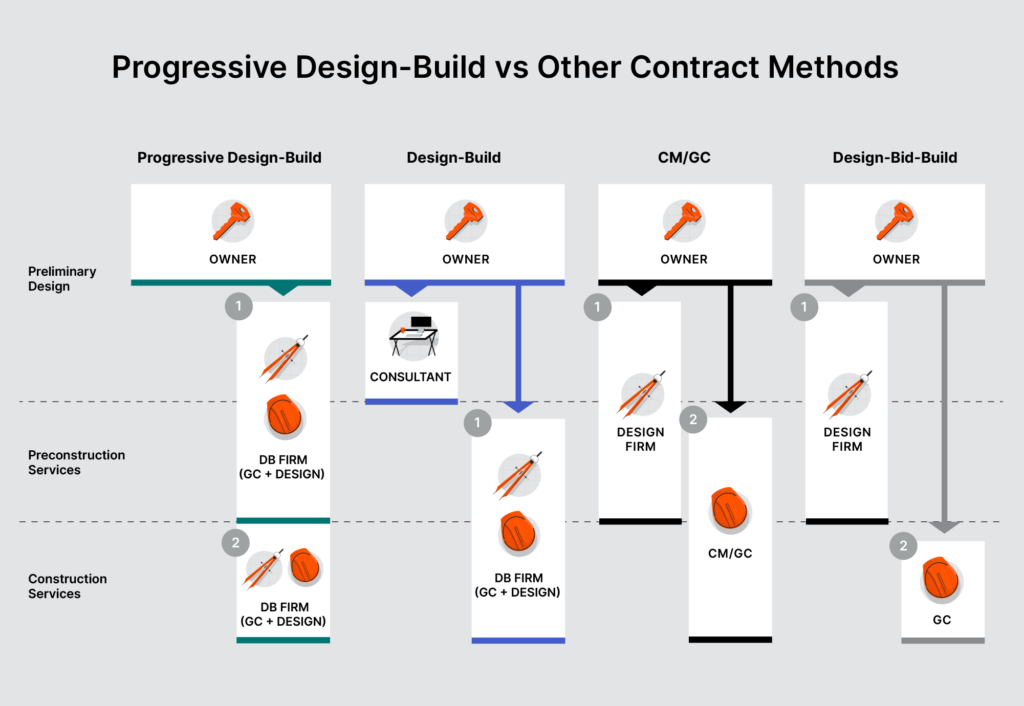— 7 min read
Progressive Design-Build: Reducing Risk With Two-Stage Procurement
Last Updated Aug 7, 2025
Alex Six
Solution Specialist, C&I Industry Specialist
16 articles
Alex Six is an Enterprise & Strategic Civil & Infrastructure Overlay Account Executive for Procore. Alex has a long background in the construction industry beginning with an internship with one of the biggest contractors in the world, and expanding across projects with teams as small as 4 people and as large as multi-billion dollar budgets with large teams and disciplines. His resume includes Caltrans highways & bridges, Metro light rail & underground, as well as airport runways and utilities.
Larry Bernstein
Larry Bernstein is a freelance writer that specializes in construction and technology. He has written for Dodge Data & Analytics, Trimble, ENR, Bluebeam, and more. He holds a bachelor's degree in economics from Penn State University, a master's in secondary education from Brooklyn College, and a master's in creative writing and literature from Long Island University. He lives in New York.
Last Updated Aug 7, 2025

Design-build (DB) is an increasingly popular method of project delivery in construction due in large part to its inherent efficiencies in collaboration and cost management. However, this method can increase risk to owners and developers, who effectively sign a construction contract before the project is fully designed and the budget developed.
A new delivery method has emerged in recent years to address this challenge: Progressive design-build is a two-stage approach to design-build contracts that can effectively mitigate risk to both owners and contractors alike by giving them an “off ramp” if they fail to reach agreement during the design phase.
In this article, we explore the structure of a Progressive Design-Build contract and the benefits of this delivery method.
Learn more about the 6 methods of project delivery in construction.
Table of contents
Progressive Design-Build: The Basics
Progressive design-build (PDB) is a branch of design-build in which the contract for design and construction is separated into two distinct phases. The selection of the DB firm is based primarily on their qualifications and design proposal. Because the design and budget has yet to be determined, construction cost and schedule is not part of the bidding or procurement process.
Phase 1: Preconstruction Services
During the first contract or phase, the design-builder works closely with the owner and their design consultants on programming. They will provide input on feasibility and constructability of preliminary designs, and continue design development. This stage of the project is highly collaborative: The contractor submits comprehensive and transparent cost estimates to the owner for simultaneous development of the project budget.
Once the design is sufficiently detailed — generally 60% or more complete — the DB contractor will submit a formal proposal to the owner with a guaranteed maximum price (GMP) for construction along with a preliminary schedule. If the owner accepts their proposal, they will either sign an extension to the original contract or create a separate contract for the construction services.
However, this is where PDB differs the most from design-build: If the owner and contractor cannot agree on the design or budget for construction services, the owner can decide to use the “off ramp” built into the PDB agreement. In this case, they will typically use the designs to bid out the construction phase of the project separately.
It is important to note that ownership of the designs at this point will depend on the original agreement – if the DB firm reserved rights to the design in the contract, the owner would need to rebid the entire project, including the design development.
Phase 2: Construction Services
Once the owner accepts the DB firm’s proposal, they will move to phase two – the actual construction of the project. If the designs haven’t been finalized, the contractor will complete the drawings and specifications and begin procurement of subcontractors and vendors.
The rest of the project will continue as a typical design-build project.
PDB vs CMAR
The Construction Manager at Risk (CMAR) or CM/GC method of project delivery is very similar to progressive design-build, and shares many of the same advantages. The Construction Manager is hired during preconstruction to consult and provide input on the constructability of the designs. However, unlike PDB, a design firm is hired under a separate contract from the CM or GC. The owner has two separate contracts: One with the CM/GC and another with the architect or design firm.
On a PDB project, the owner has a single contract with the design-builder who provides both design and construction services, streamlining communication throughout each phase of the project.

Unique Features of Progressive Design-Build
As an offshoot of design-build, PDB shares several key elements with its parent delivery method. However, the two-stage structure of the contract creates a unique relationship that brings unique features to the table.
Transparent Estimating & Budgeting
Progressive design-build is highly collaborative, and the owner is generally highly involved in estimating and budgeting discussions. During the initial phase of the contract, the design-builder shares transparent cost information with the owner as the budget is developed. The owner and DB firm want to reach an agreement on the construction phase, so cost transparency helps reduce disagreements or disputes during the budget negotiation.
Number of Contracts
A typical design-build project uses a single contract with a design-builder who performs both design and construction services. The price for the entire project is set during the contractor selection process.
Progressive design-build, by contrast, uses a single contract in two phases (or, in some cases, two separate consecutive contracts). The owner and design-build firm enter into one agreement for design services. During design, they will negotiate the cost for the construction phase and enter into a second agreement (or an extension of the original contract) for the construction phase.
A traditional Design-Bid-Build (DBB) project typically consists of two separate contracts: One with the designer and a second with the contractor.
Off Ramp
One of the defining features of a Progressive design-build (PDB) project is that it offers the parties an off-ramp. If the owner and design-build team (DB team) can’t agree on pricing before moving on to the construction phase, they can agree to part ways.
Owners may or may not retain all intellectual property, including the designs, if they part ways with the design-builder. This detail is generally negotiated in the initial design contract.
Design-build (DB) is the most similar to Progressive design-build (PDB) in that one team handles design and build. However, it offers no such off-ramp. The parties are married to each other until the project is complete.
Project Cost Negotiation
One of the key differences between Progressive design-build (PDB) and traditional design-build (DB) is when the contract price for the construction phase is negotiated. On a design-build (DB) project, the contractor typically submits a single proposal and price for the entire project, including both design and construction. The contract amount for all services is set up front.
Progressive design-build (PDB) essentially separates the construction phase into a separate agreement. The budget for construction is negotiated during the design phase, typically when the designs are nearly complete. If the two parties can't agree on a price, the owner can terminate the relationship and explore other contracting options.
Qualification-Based Selection
Owners select the design-build team (DB team) based primarily on their qualifications, rather than price, in the Progressive design-build (PDB) method. This is because the price for construction services is negotiated after the team has made significant progress on the design.
Design Process
With Progressive design-build (PDB), the design-builder team is the major player in terms of design. They’re selected before a baseline design has been developed. This is similar to Construction Manager at Risk (CMAR).
However, it contrasts with design-build (DB), where the owner’s team develops a baseline design. Then, a design-builder team creates something based on the owner’s design.
Stay updated on what’s happening in construction.
Subscribe to Blueprint, Procore’s free construction newsletter, to get content from industry experts delivered straight to your inbox.

When to Choose Progressive Design-Build
Despite its advantages, progressive design-build isn’t necessarily the right delivery method for every project. Owners or developers that have built similar projects in the past can typically draw on historical cost data for accurate budget forecasting.
Progressive design-build can be a good choice for owners developing complex projects with a variety of unknowns. For example, PDB may be attractive when the project:
- Is located in a state or region where the owner or developer hasn’t built before
- Differs substantially in scope or scale from past projects
- Is similar to others that have historically gone over budget
- Could be built on several different sites
PDB can also benefit owners who want to try working with a new, untested DB firm.
Build collaboratively with progressive design-build.
Ultimately, choosing a delivery method depends on a wide variety of factors, and no contracting method will work on every project. For risk-averse owners and developers, or those seeking a more collaborative approach, progressive design-build may provide the right fit.
Was this article helpful?
Thank you for your submission.
98%
2%
You voted that this article was . Was this a mistake? If so, change your vote
Scroll less, learn more about construction.
Subscribe to The Blueprint, Procore’s construction newsletter, to get content from industry experts delivered straight to your inbox.
By clicking this button, you agree to our Privacy Notice and Terms of Service.
Thank you!
You’re signed up to receive The Blueprint newsletter from Procore. You can unsubscribe at any time.
Categories:
Written by
Alex Six
Solution Specialist, C&I Industry Specialist | Procore Technologies
16 articles
Alex Six is an Enterprise & Strategic Civil & Infrastructure Overlay Account Executive for Procore. Alex has a long background in the construction industry beginning with an internship with one of the biggest contractors in the world, and expanding across projects with teams as small as 4 people and as large as multi-billion dollar budgets with large teams and disciplines. His resume includes Caltrans highways & bridges, Metro light rail & underground, as well as airport runways and utilities.
View profileLarry Bernstein
Larry Bernstein is a freelance writer that specializes in construction and technology. He has written for Dodge Data & Analytics, Trimble, ENR, Bluebeam, and more. He holds a bachelor's degree in economics from Penn State University, a master's in secondary education from Brooklyn College, and a master's in creative writing and literature from Long Island University. He lives in New York.
View profileExplore more helpful resources

Using Standard Operating Procedures for Better Contract Management
Every construction project is different, meaning that GCs have to be continually agile and strategic about applying their experience. Major categories change from project to project, from the owner to...

Understanding Supplementary Conditions on Construction Contracts
No two construction projects are exactly alike — and the same goes for construction contracts. Even when using a standard contract form, owners and contractors sometimes use supplementary conditions to...

A Straightforward Guide to Construction Contract Review
Construction contracts are like the glue for the project team. They’re the ties that bind the working relationships and goals for the project, containing information about responsibilities, liabilities and processes...

Escalation Clauses in Construction Contracts: When and How They Apply
In construction contracts, an escalation clause allows for the escalation of a certain price for labor or materials to be used in a construction project. This type of clause is most...
Free Tools
Calculators
Use our calculators to estimate the cost of construction materials for your next project.
Templates
Find a template to help you with your construction project tasks.
Material Price Tracker
Get the latest U.S. retail prices and view historical trends for common building materials.
Glossary
Explore key terms and phrases used in the industry.
